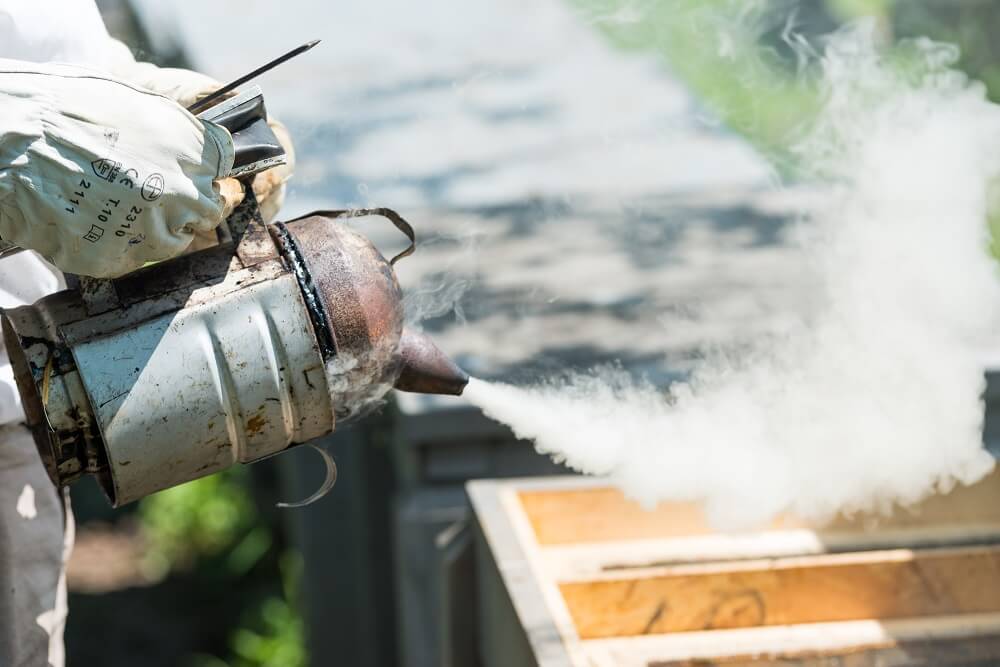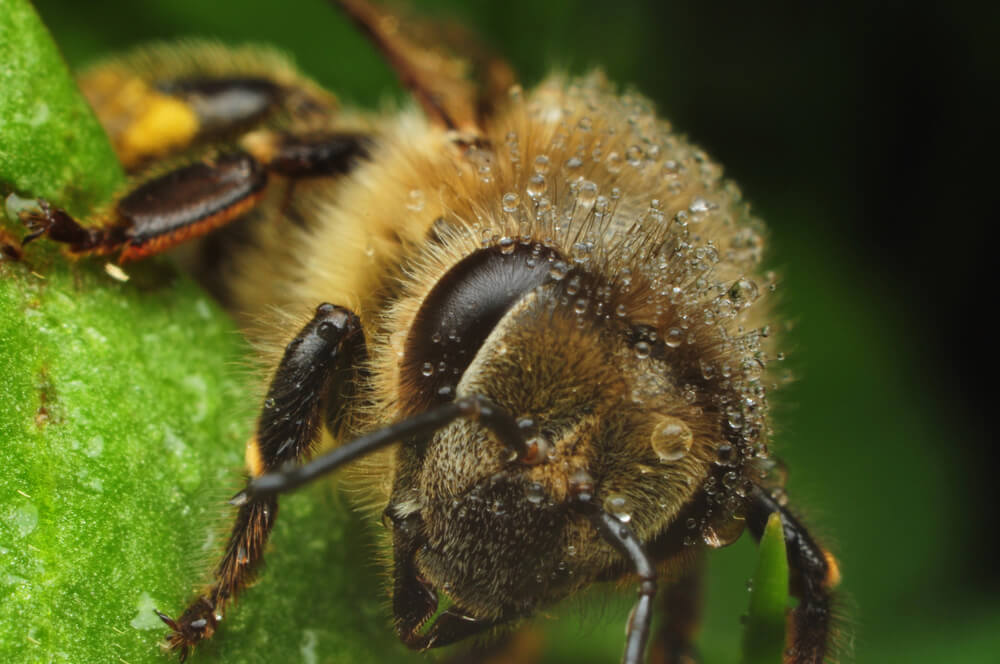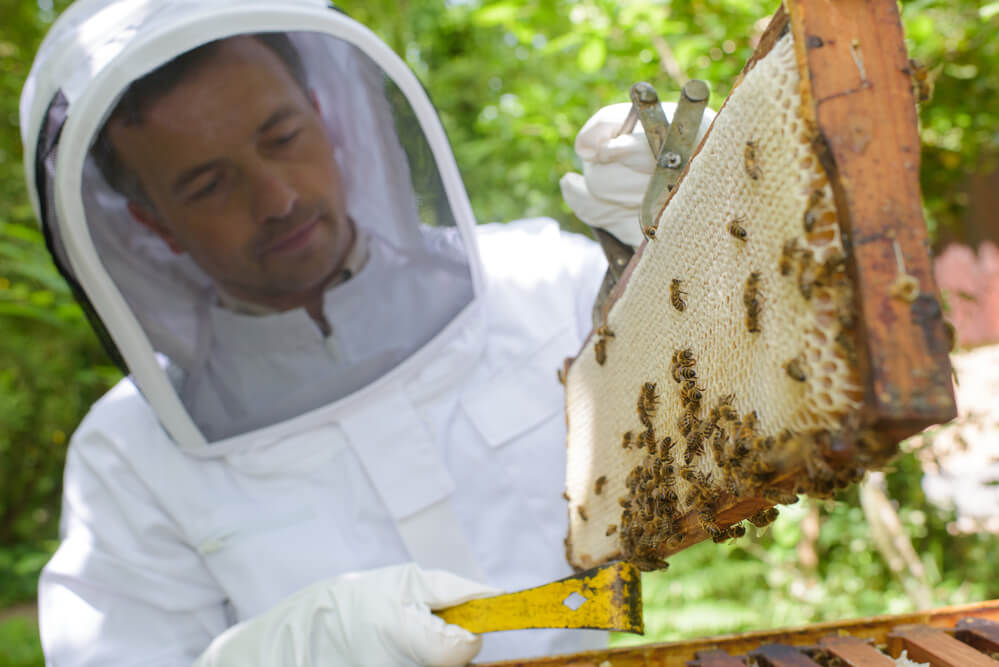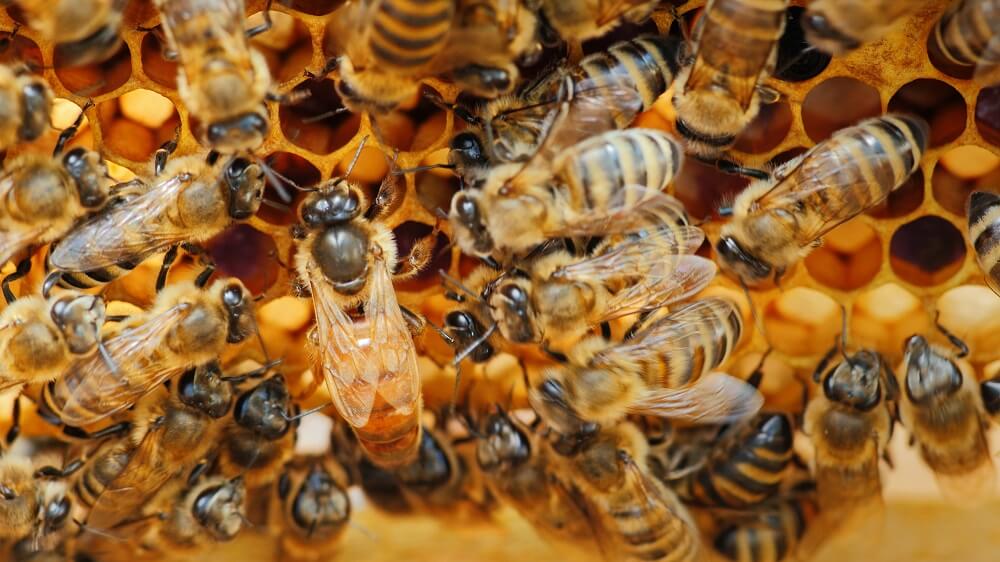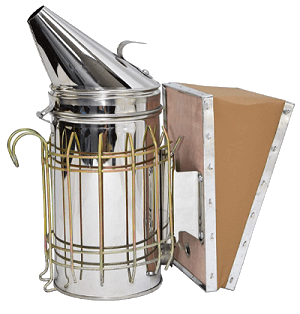In this article:
Let me guess.
You’re a new beekeeper who’s searching for the best bee smoker.
But first, you have some questions:
What are bee smokers, exactly?
And more importantly, are bee smokers harmful to bees?
These are great questions.
As a beekeeper, your bee smoker is a crucial tool in keeping your hive calm and preventing bee stings.
So let’s start at the beginning…
What is a Bee Smoker, Anyway?

A bee smoker is a device beekeepers use to puff smoke onto their bees. Most beekeepers call them “smokers” for short.
And here’s the thing:
The smoke doesn’t hurt bees. Instead, it calms the bees down so the beekeeper can safely work around the hive.
So how does it work?
Simple.
Bees release pheromones when they think they’re under attack. These pheromones alert the hive to danger and help them protect themselves. A bee smoker masks these pheromones.
But that’s not all.
Smoke also encourages bees to start eating their honey because they assume there’s a fire. And when there’s a fire, bees need to gather as much honey as possible then leave their hive.
I know that sounds intense, but it’s just a way to keep your bees preoccupied while you inspect the hive.
The upside?
You only need a few puffs of smoke to distract your bees.
But first things first:
You want to start by puffing some smoke on your skin to ensure it’s not too hot. If it’s too hot for you, then it’s too hot for your bees.
With that in mind, bee smokers consist of three key parts:
- The nozzle
- The bellow
- A fire chamber
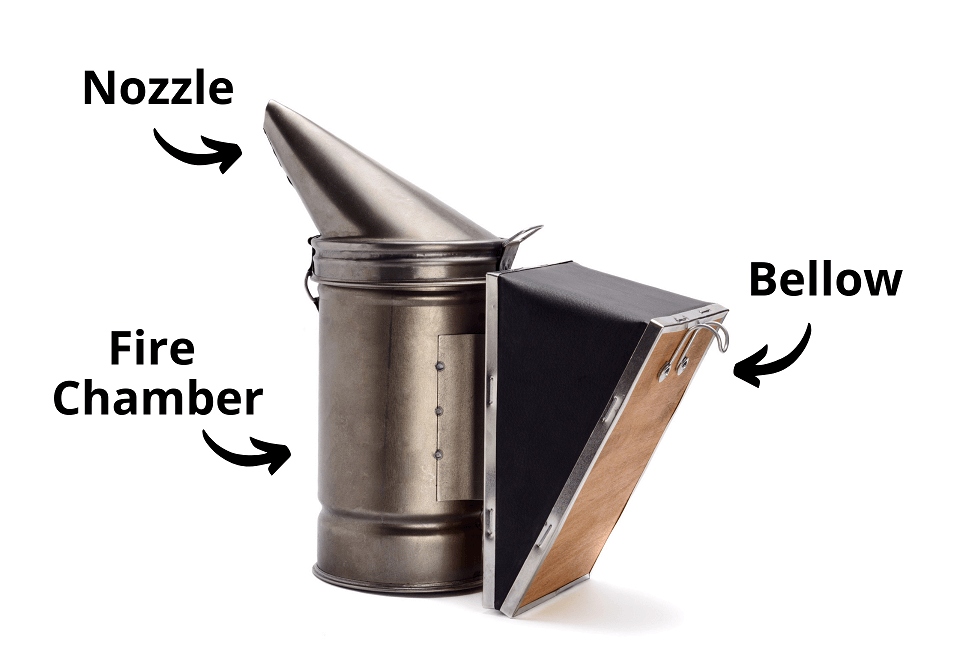
Squeezing the bellow sends a puff of smoke out from the nozzle. The fire chamber is where you light your smoker fuel to create the smoke.
Speaking of bee smoker fuel, let’s talk about that next…
What’s the Best Bee Smoker Fuel?
The answer?
It depends.
There are many great types of smoker fuels, including:
- Pinestraw
- Burlap
- Dry hay or grass
- Wood pellets
- Cardboard
- Twigs
The good news?
You can find many of these smoker fuels around your yard or home.
Because here’s the deal:
As a new beekeeper, you already have to purchase a bee suit and hive tools. Once you get established, you’ll need a honey extractor.
What am I saying?
Beekeeping equipment can add up fast, so saving money where you can is ideal.
But there are a few disclaimers:
Never use chemicals or paper that’s been bleached as bee smoker fuel. Bees are sensitive to chemicals, and you don’t want to harm – or worse – kill them.
For example, if you’ve sprayed your lawn with chemicals, you should avoid using grass from it.
Secondly, you want a bee smoker fuel that burns at a low temperature, so it doesn’t injure your bees. Bees only need to feel a cool, gentle breeze of smoke. Anything that burns too fast and hot won’t work.
But how can you tell?
Easy.
Check the temperature of your smoke by puffing it on your arm or hand. It should feel comfortable on your skin.
If it feels too hot, add more smoker fuel to reduce the temperature.
Remember:
The goal is to produce smoke – not fire.
And in summary, avoid using:
- Anything contaminated with chemicals
- Plants that harm or deter insects
- Anything that produces smoke that’s too hot
- Lighter fluid, gasoline, kerosene, etc
Our 3 Best Bee Smoker Picks
Bee smokers range in price from $15 to $50+, but you don’t need to spend a fortune to get a great quality smoker.
Here are a few of our top picks:
1. Vivo Bee Smoker
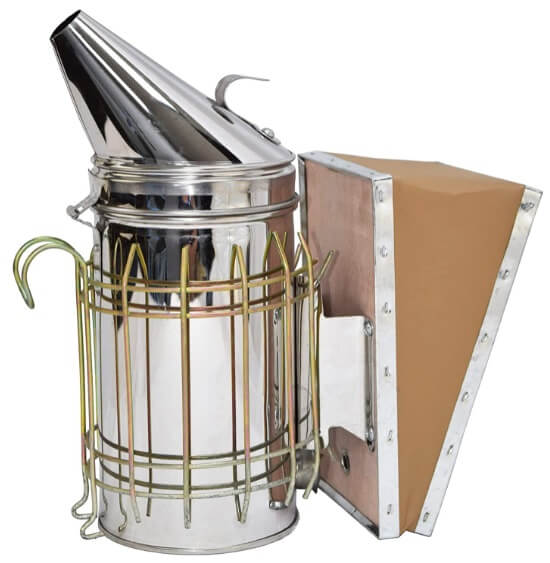
4.6 stars on Amazon
It’s easy to get cool smoke with this bee smoker. It’s high-quality stainless steel that holds up well. Also, you’ll appreciate that it has a metal cage around it that acts as a heat shield so you don’t get burned. It also has a hook for hanging.
Customer reviews of this bee smoker:
“I just finished my first year as a beekeeper. As any beginner knows, getting all the beekeeping equipment can be costly. That’s why I tried to save money where I could. I went cheap with this one, and it’s been great. No regrets at all because it worked like a champ all summer.”
“This bee smoker is easy to use and gives off hours of smoke if packed well. We used it to remove a hive from a house. Just remember to be cautious where you set it because the bottom gets hot.”
“This smoker works just as designed, which makes it a nice buy for the price. The construction is solid, and the leather bellows are securely stapled on all four sides. It stands up well to heat.”
2. Honey Keeper Bee Smoker
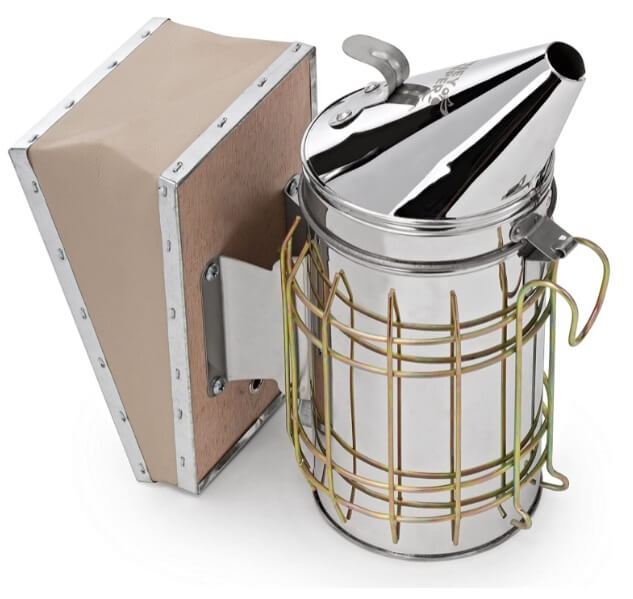
4.6 stars on Amazon
This is another great stainless steel bee smoker with a metal cage for heat protection. It burns well and produces plenty of smoke.
It also stays lit for 2+ hours, so this is perfect if you’re working with several hives.
Customer reviews of this bee smoker:
“This is a good tool. It’s easy to light and makes a nice, cool smoke. It stayed lit for two hours and still had fuel in it when I was finished. I own an expensive bee smoker, but I’d rather use this model.”
“I’ve owned this bee smoker for three years now. It’s a crucial beekeeping tool. I lost it and was running around trying to find it at one point. I finally found it lying in the grass not far from my apiary and realized it had fallen off my truck. It had rained a lot between the time it had fallen and when I found it, but the bee smoker was completely fine. It was a testament to the durability of its materials.”
“This bee smoker was about half the price of the same one I bought locally. I filled it with pine straw and cones. It lit fast and stayed at a good cold smolder until all the fuel was gone. It gave me plenty of smoke. The bellows look and feel durable and it’s high-quality for the price. Great little smoker!”
3. Blisstime Bee Smoker
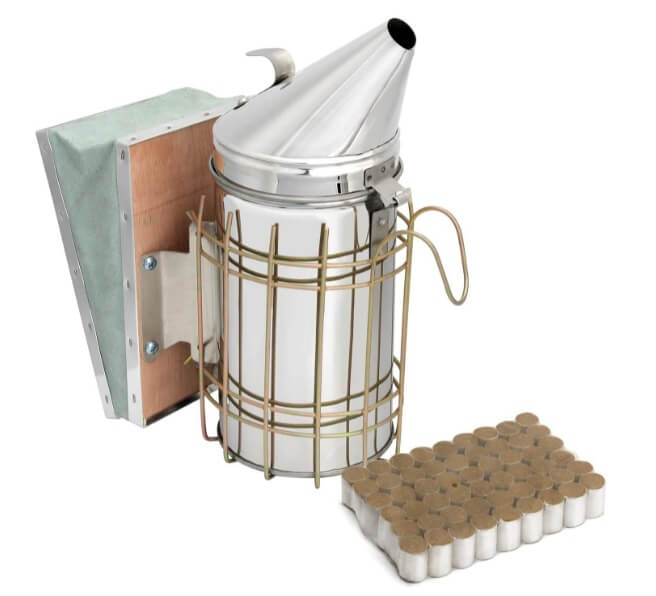
4.6 stars on Amazon
This is a sturdy smoker with a heat guard and a hook for hanging. It comes with bee smoker pellets that you can use to get the fire started. You might need to use more than one pellet to get enough smoke.
That said, this is a great starter bee smoker.
Customer reviews of this bee smoker:
“Great quality, I’m happy with what I got for the price. I would recommend.”
“I’ve only used it a few times but so far, so good for a small beekeeper with five hives.”
How to Light and Use a Bee Smoker
Thankfully, learning how to start a bee smoker is straightforward.
Step 1: Crumple up a piece of paper and put it into the bottom of your smoker. Next, light that paper.
Step 2: Fill your bee smoker with fuel. Remember, this can be pine straw, burlap, cardboard, etc.
Step 3: Once lit, apply a few puffs of smoke to your skin to ensure it’s not too hot. Once you get a nice, cool smoke, lightly smoke one side of the hive before opening the cover. Avoid smoking all sides of the hive because this will make the bees feel trapped. Just a few quick puffs on one side are needed.
Step 4: After smoking, give it 30 seconds to affect the bees.
Step 5: Avoid over-smoking your hive. More smoke doesn’t equal calmer bees and can drive them away from their hive. A few short puffs will do the trick.
Step 6: To put the fire out, dump your smoker fuel into a bucket of water when you’re done. You can also stuff some grass (or a cork) into the spout and lay the bee smoker on its side. This is another way of extinguishing the fire.
How to Clean a Bee Smoker
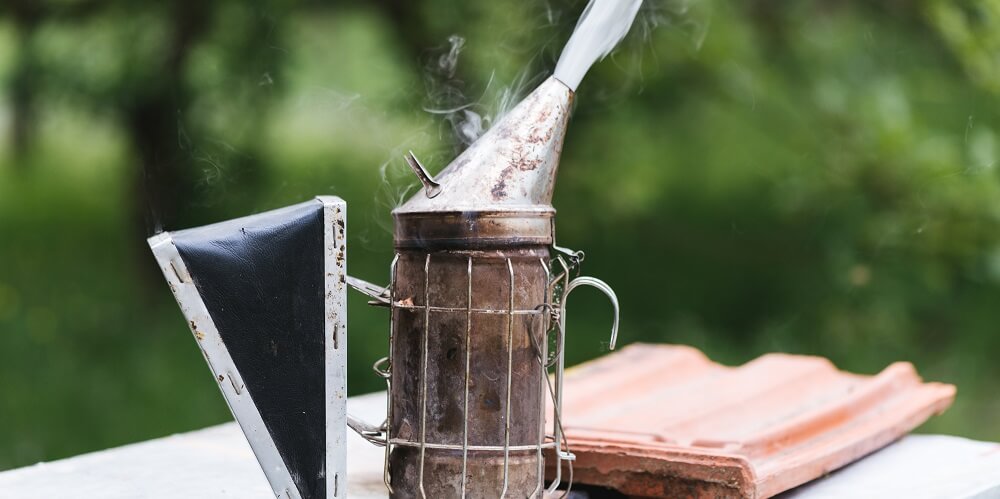
Cleaning your bee smoker ensures that it doesn’t get clogged. You can clean your bee smoker once or twice per year or more if you use it often.
Here are the steps:
Step 1: Pour out the loose contents
This includes smoker fuel or ashes in the fire chamber. Make sure nothing is lit when you pour it out. Next, take your hive tool and scrape away anything that’s stuck inside.
Step 2: Remove the bellow
Most bee smokers have removable bellows that unscrew. Since we’ll soak the bee smoker in a water mixture, we don’t want the bellows to get wet.
Step 3: Mix vinegar with water to create a cleaning solution
Fill a bucket with enough water to cover your smoker, then add one to two cups of vinegar into the water. Let your bee smoker soak overnight in the cleaning mixture.
If your bee smoker doesn’t have removable bellows, only fill the bucket with enough water to cover the fire chamber and not touch the bellows.
Step 4: Wipe away residue
Use a rag to wipe away any leftover dirt or ash. Finally, hang your bee smoker out to dry.
FAQs about Bee Smokers
- Is a bee smoker harmful?
- Is a bee smoker necessary?
- How often should you smoke bees?
- How do you calm bees without smoking?
- What do you burn in a bee smoker?
- Can you over smoke a beehive?
- How do you light a bee smoker?
- How long do bee smokers last?
- Who invented the bee smoker?
- What causes bees not to be calm?
- What should I look for in a bee smoker?
Is a bee smoker harmful to bees?
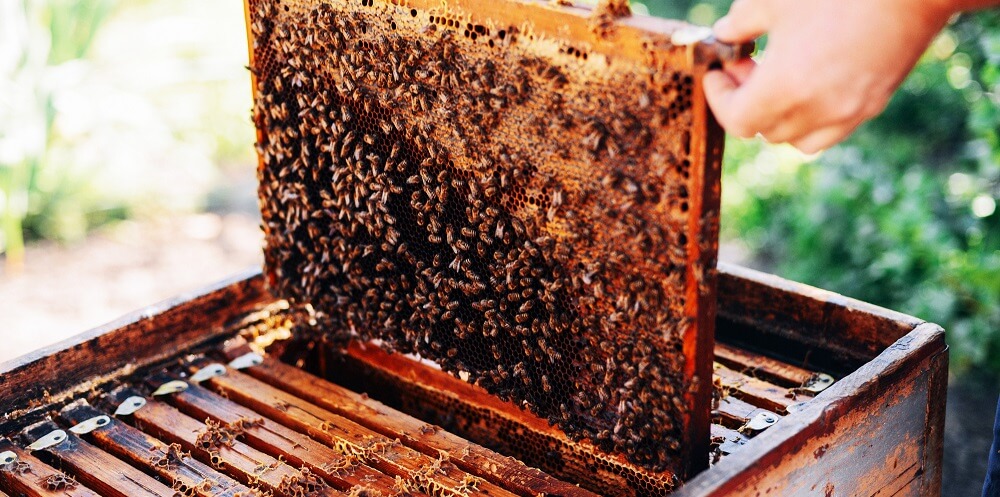
Not at all!
Smoke from a bee smoker doesn’t hurt bees. It simply interferes with their sense of smell, preventing them from going into attack mode.
In a nutshell:
Bees release specific pheromones when they think there are harmful intruders. A bee smoker masks this smell and allows the bees to remain calm.
And here’s the thing:
Using a bee smoker is good for both beekeepers and bees. When bees don’t go into attack mode, fewer bees die because of stinging.
Also, it allows the beekeeper to finish the hive inspection faster since the bees are calmer.
—> Go back to the FAQs about bee smokers
Is a bee smoker necessary?
As with many things in backyard beekeeping, you’ll get different answers depending on who you ask.
My opinion?
Your bee smoker is one of the most essential accessories for minimizing stings. It not only saves you from getting stung, but it minimizes bees dying due to stinging.
That’s why I believe a bee smoker is just below your bee suit in terms of the most crucial beekeeping equipment.
But don’t forget:
Only a few puffs of smoke on one side of the hive is necessary. You don’t want to go overboard with the bee smoker because it can cause your bees to flee the hive.
—> Go back to the FAQs about bee smokers
More to Explore:
How often should you smoke bees?
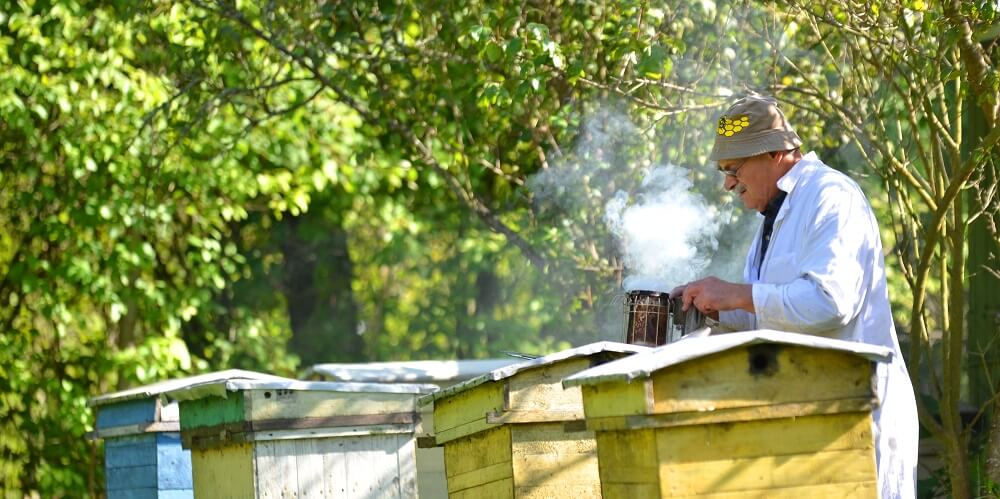
A puff or two of smoke every three or four minutes will do the trick. That said, it also depends on the weather, the hive strength, or the mood of your colony.
Once you get a few seasons of backyard beekeeping under your belt, you’ll learn your bees and understand their needs.
I recommend keeping your bee smoker handy for every single hive inspection you do. It’s the easiest way to calm your bees and prevent unnecessary stings.
—> Go back to the FAQs about bee smokers
How do you calm bees without smoking? Are there any alternatives to bee smokers?
Using a bee smoker is the most effective way to calm your bees.
That said, here are a few tricks that can help:
Tip 1: Pick the right time to inspect the hives
Bees are picky when it comes to weather and temperature. For example, you don’t want to open their hives at night or when it’s cloudy and cold.
My recommendation?
Inspect your hives on a warm, sunny day between 11:00 am and 2:00 pm. During this time, the worker bees will be out foraging for food. This means you’ll have fewer bees to contend with during your inspection.
Avoid opening the hives when it’s windy, rainy, or cold out. These weather conditions aren’t ideal for bees and can cause them to be crankier than usual.
Also, consider options like the flow hive. It allows you to pour honey straight from the hive without disturbing your bees.
Tip 2: Wear the right colored clothing
Your bee suit should always be white or light in color.
These days, I’ve seen several bee suits that come in various colors, from dark green to hot pink.
While they look cool and different, they aren’t exactly the best for beekeeping.
Here’s why:
Bees find dark colors to be aggressive.
How come?
Well, think about it like this.
Many of bees’ natural predators are dark in color. This includes bears, skunks, and beetles. So when you wear dark colors, the bees can interpret that as a threat to their colony.
And as a result?
It can cause your bees to become defensive and go into attack mode.
Also, this includes dark hair too. If you have long dark hair, pull it back in a tight bun and wear face protection.
Tip 3: Be aware of your smell
Avoid wearing anything that’s heavily perfumed, like lotions, shampoos, or fragrances.
Also, avoid eating bananas or citrus before tending to your hives. Both of these scents can throw off your bee’s pheromones and cause them to become defensive.
Your best bet is to be clean and unscented. No harsh odors coming from your clothes or breath.
Tip 4: Work slowly and quietly
Bees are sensitive to fast movements and vibrations, so you want to keep your movement slow and steady. Moving slow and methodically also allows you to be careful when handling your hive.
If you’re rushed, then you might accidentally crush some bees. Not good.
Also, do your hive inspections during a quiet part of the day. For example, avoid checking on your bees when your neighbor is mowing their lawn.
Reducing unnecessary noises reduces the chances of your bees getting agitated.
This is also why many expert beekeepers keep talking to a minimum during hive inspections.
Tip 5: Spray your bees with a sugar-water mixture
When working with a new package of bees, sugar water is often the go-to over smoke.
Why?
Because sometimes spraying a new hive with smoke can deter them from their new home. If they feel that there’s a danger of “fire,” they can flee the hive.
That’s why many beekeepers spray their new hives with a 1:1 sugar-water mixture.
For example, mix one cup of regular white sugar with one cup of warm water. Stir the sugar until it dissolves, then cool to room temperature.
Once cooled, pour your sugar water into a spray bottle. Next, you’ll open your hive and gently mist your bees with the sugar water. Just give them a few sprays to get a light coating of sugar water over their bodies.
Give them a minute or two for the sugar water to take effect.
Now you might be asking:
But wait, how does sugar water work to calm bees?
To put it simply, the sugar syrup encourages your bees to clean themselves and each other. This gives you time to do your inspection while the bees are busy cleaning themselves.
After your hive becomes established, you can switch to using a bee smoker.
As with any method, there are pros and cons to using one over the other.
Pros of using sugar water instead of a bee smoker:
- Sugar water is ideal for new or weak hives since it won’t deter them from their home
- The sugar water is easy to make
- You don’t have to worry about finding smoker fuel
- You don’t have to worry about keeping your bee smoker lit while doing your inspection
- You can’t burn your bees with sugar water
- Sugar water isn’t a fire hazard
- Sugar water is ideal for people with asthma or people who are sensitive to smoke
Cons of using sugar water instead of a bee smoker:
- You have to open the hive to spray the sugar water. This already puts you at a disadvantage. A bee smoker allows you to give a few puffs of smoke before opening the cover, which helps calm the bees from the beginning
—> Go back to the FAQs about bee smokers
What do you burn in a bee smoker?
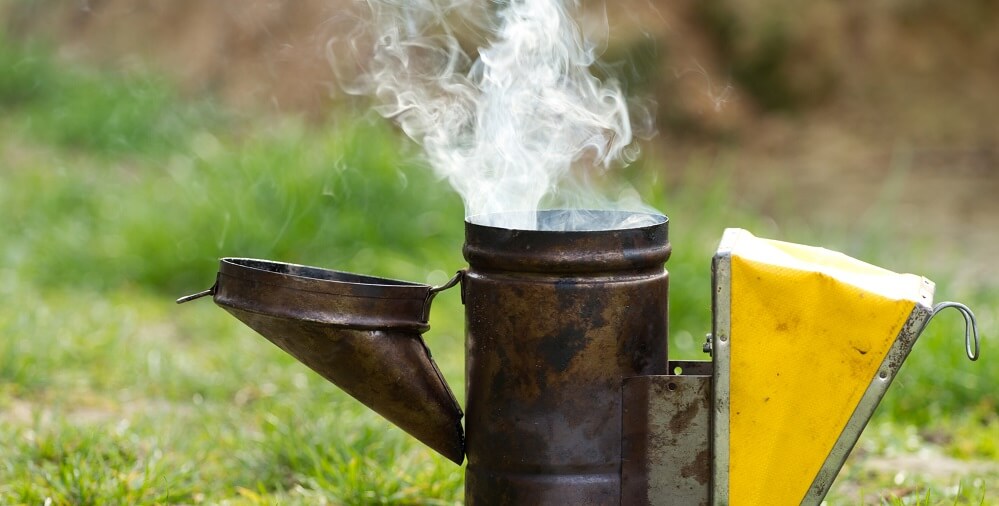
There are several things you can use as bee smoker fuel.
Even better?
Most smoker fuels are free because you can find them around your yard or home.
Here are a few:
1. Pine Needles (aka pine straw)
Pine needles are easy to light and give off a cool smoke. The best way to light pine straw is to ball up some paper and light it in the bottom of your bee smoker.
Then fill your smoker with dry pine needles and pump your bellow to produce smoke.
And here’s the thing:
Make sure you keep your smoker full of pine needles so you can produce cool smoke. If you don’t have enough pine needles in your smoker, then it’ll start to smolder and get hot.
Remember, bees need a cool, white smoke.
As always, puff some smoke on your arm to test the temperature before using it on your bees. It should feel comfortable on your skin – not overly warm or hot.
2. Burlap
Untreated burlap is a favorite amongst beekeepers because it’s easy to light and stays lit.
More importantly?
It gives off just enough cool, white smoke to calm the bees. The smoke from burlap tends to be more mild compared to pine straw.
But there’s one important key:
Make sure the burlap you buy is untreated. Bees are sensitive to chemicals and smells, so treated smoker fuel can release toxins into their hives.
3. Dried Grass or Hay
Like pine needles, dried grass is easy to light and keep burning.
Start by cutting your grass and letting the clippings dry in the sun. Then light a piece of paper at the bottom of your smoker to get the fire started.
Next, place your dried grass or hay clippings on top while pumping the bellows of your smoker.
Once your smoker is full, close the lid and pump the bellows a few more times to get a cool smoke.
4. Raw Cotton
Raw cotton is ideal because it lights easily and produces a continuous burn. It smolders nicely and never has an open flame.
And because it smolders, it’ll last longer than other types of bee smoker fuel. It also doesn’t have resins that’ll gum up your smoker.
5. Wood Pellets
Wood pellets are often recommended to beekeepers.
The advantage of using pellets is that they produce clean smoke that can burn for long periods.
That said:
Wood pellets can be tricky to get started. You’ll need to light small pieces of paper or cardboard first at the bottom of your smoker. Then add your wood pellets on top to get them lit.
Also, wood pellets can produce hot smoke, which isn’t good for bees. That’s why many beekeepers top their wood pellets with other smoker materials to keep the smoke from getting too hot.
With that in mind, you’ll need to double-check the temperature of your bee smoker if you’re using wood pellets. Puff some of the smoke on your arm to ensure it’s not too hot.
It needs to be a cool, white smoke.
Related: How Many Bees are in a Hive?
—> Go back to the FAQs about bee smokers
Can you over smoke a beehive?
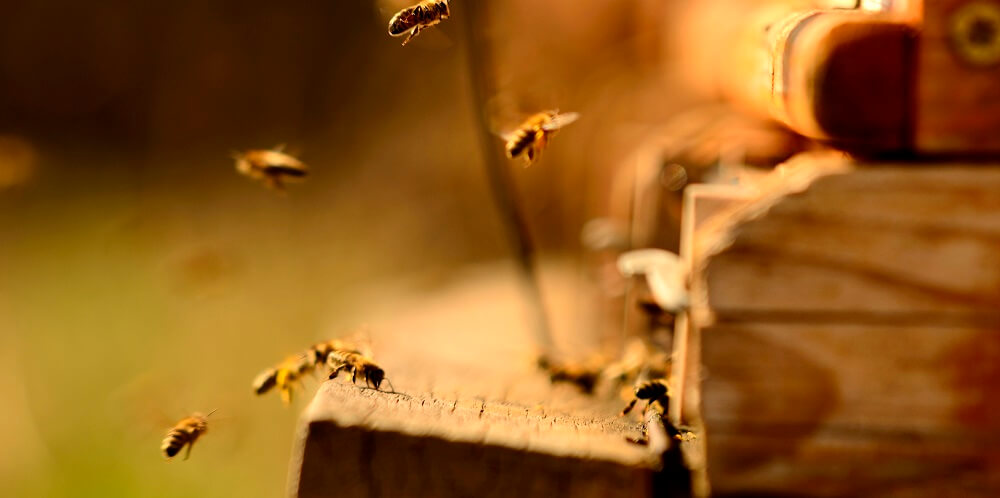
Yes, too much smoke can make your bees flee their hive.
Why?
Because over smoking your hive will cause your bees to go into a panic because they believe a “fire” is nearby.
That’s why I emphasize three things:
1. Use your bee smoker sparingly. Only one to two puffs of smoke every three to four minutes are necessary.
2. Ensure that your smoke is a cool, white smoke. It should feel nice against your skin. Anything too hot will disturb your bees.
3. Only smoke one side of the hive. Never smoke around the entire hive because it can make your bees feel trapped.
Also, don’t smoke down between the frames of your hive. Instead, lightly puff smoke across the top bars. These tips are useful no matter what type of hive you buy: a vertical or horizontal hive.
—> Go back to the FAQs about bee smokers
More to Explore:
How do you light a bee smoker?
It’s the million-dollar question.
As a new beekeeper, you might find it a little tricky to light your bee smoker. Heck, sometimes even experienced beekeepers struggle with this.
We covered the steps for lighting your bee smoker above, but here’s another quick rundown:
Step 1: Crumple some paper and place it into the bottom of your bee smoker. Light the paper and squeeze your bellows a few times to get some air into your smoker.
Step 2: Stuff your bee smoker with fuel. Your fuel of choice could be pine straw, burlap, dry grass, or anything we’ve previously mentioned.
Step 3: Give your bellows a few squeezes while you’re stuffing your smoker with fuel to help with the fire.
Step 4: Close the lid and test the smoker on your arm or hand. You want to ensure the smoke is cool, so it doesn’t bother your bees.
—> Go back to the FAQs about bee smokers
More to Explore:
How long do bee smokers last?
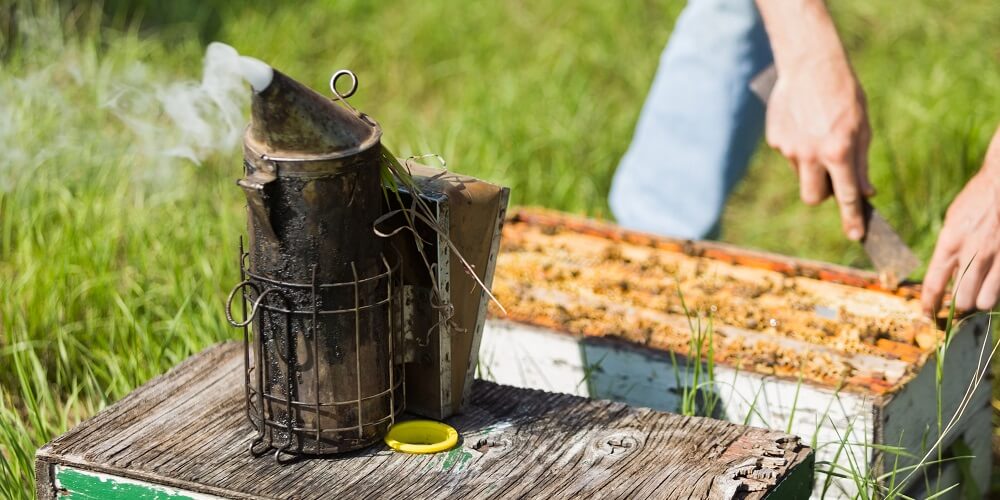
If you take care of your bee smoker, it can last several years.
Now you’re probably asking:
How do I take care of my bee smoker?
The best way to maintain your smoker is to clean it at least once or twice per year. Of course, you may need to clean it more frequently if you maintain several hives and use it often.
—> Go back to the FAQs about bee smokers
More to Explore:
Who invented the bee smoker?
Moses Quinby is credited with inventing the bee smoker. Quinby was born in New York in 1810 and is known as the father of practical beekeeping.
He authored several articles and books on beekeeping. And more than 100 years after his death, we still use several of his techniques to this day.
—> Go back to the FAQs about bee smokers
More to Explore:
What causes bees not to be calm?
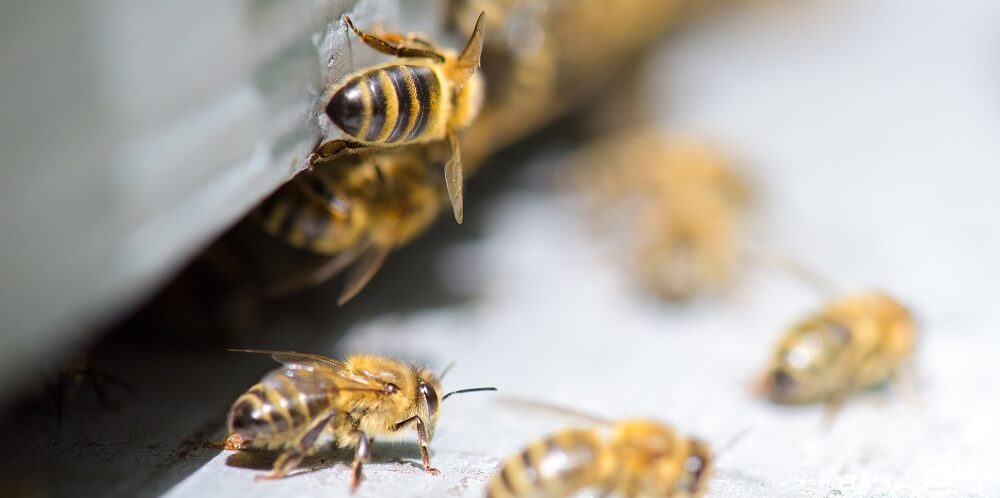
Great question.
The more you understand your bees and their likes and dislikes, the better you’ll be at beekeeping.
There are a few reasons your bees might be agitated:
Reason 1: Bad weather
Spoiler alert:
Honeybees prefer calm, warm, and sunny weather.
This means doing your hive inspections during cloudy, cold, windy, or rainy weather should be avoided if possible.
In fact, bees will stay home during bad weather because flying on such days can put them at risk of death. Heavy rain can slow them down by wetting their wings.
Even worse?
If raindrops are coming down too big or fast, they can actually break a bee’s wing.
Not good.
Also, rain is the enemy of harvesting nectar and pollen.
So the bottom line is this:
Perform your hive inspections during ideal weather between 11:00 am and 2:00 pm. The worker bees will be out foraging for food, so you’ll have fewer bees to contend with.
Reason 2: Hunger
Like humans, bees can get hangry.
This is why it’s important to plant the best flowers for bees and give your bees access to a safe bee waterer.
Not only that, but you may need to make sugar water for bees to help them get established. This is especially true for new or weak colonies.
Also, if you’re not getting enough rain in your area, this can lead to a nectar dearth that causes robbing behavior. Robbing happens when one colony steals honey from another.
This is why I recommend keeping a supply of sugar water for bees. This can save their life in more ways than one.
Reason 3: Predators
Predators that lurk around your hives can cause bees to go into defense mode.
The bad news?
Bees have more predators than you can count. Because the truth is, honey is like liquid gold, and many animals are drawn to it.
Not only that, but some predators eat the bees themselves. For example, skunks will entice bees out of their hive and pick them off one by one.
But don’t let this scare you.
You can learn how to defend your hive from predators and keep your bees safe. People have been beekeeping for ages, and there are several good techniques for keeping pests away.
Reason 4: Queenless Hive
Queenless hives become more feisty than normal.
Why?
Well here’s the thing:
It doesn’t take long for your hive to realize they no longer have a queen. This is because the queen bee releases pheromones that help the other bees detect her.
So without the queen’s scent, the hive will be alerted that they are queenless within hours.
And when they do?
They realize their hive is in danger, and they’re unwelcoming to interference as they try to get another queen.
The good news is that their aggressive behavior usually subsides as soon as the beekeeper or colony replaces the queen.
—> Go back to the FAQs about bee smokers
More to Explore:
What should I look for in a honeybee smoker?
There are endless bee smokers on the market. With that in mind, here’s what you should look for:
- A large enough fire chamber to hold smoker fuel so you don’t have to refill it often. Of course, this depends on how many hives you have. If you only have one or two hives, a smaller fire chamber will work.
- A metal guard around the fire chamber that protects your skin from burns
- Positive reviews from other beekeepers. Reading reviews and doing research will help you make a smart purchasing decision.
